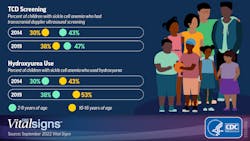In 2019, less than half of children aged 2–16 years with sickle cell anemia received the recommended screening for stroke, a common complication of the disease, according to a new CDC Vital Signs report. In addition, many of these children are not receiving the recommended medication, hydroxyurea, which can reduce complications such as pain and acute chest syndrome. Hydroxyurea can also improve anemia and quality of life.
Sickle cell anemia is the most severe form of sickle cell disease, which is a red blood cell disorder that primarily affects Black and African American people. It’s estimated that sickle cell disease affects approximately 100,000 Americans.
Data from more than 3,300 children with sickle cell anemia continuously enrolled in Medicaid during 2019 were analyzed in this report. The data came from the IBM MarketScan Multi-State Medicaid Database.
Key findings:
- About half (47%) of children aged 2–9 years and 38% of children aged 10–16 years received transcranial Doppler (TCD) ultrasound to assess their risk for stroke. Sickle cell anemia is a leading cause of childhood stroke.
- Only 2 in 5 children aged 2–9 years and about half of children/teens aged 10–16 years with sickle cell anemia used hydroxyurea.
- Both the stroke screening and hydroxyurea use were highest among children with high levels of healthcare use, as well as those with evidence of prior complications from their disease.
Many people with sickle cell anemia report barriers to receiving the recommended screening and treatment. Structural racism is one of those barriers. For example, despite their extensive healthcare needs, many people with sickle cell anemia do not have access to providers with expertise in treating the disease or report feeling stigmatized and having their symptoms dismissed when they do receive care. Other barriers include concerns among parents and providers about potential side effects and effectiveness of hydroxyurea.
Much can be done to help children with sickle cell anemia and their families:
- Healthcare providers can work to consolidate care by integrating screening into a single, comprehensive healthcare visit for children with sickle cell anemia.
- Healthcare institutions can develop formal reporting systems to document and respond to racist behavior and empower people with sickle cell anemia to safely report concerns about prejudice or inequality.
- Healthcare providers can work with policy makers and advocates to reverse the impact of years of structural racism on sickle cell anemia funding, research, and policy decisions.
- Patients and their families can learn about the importance of getting an annual screening for stroke and talk to their healthcare provider about the results of the screening and next steps.
- Community-based organizations and other partners can develop resources for both patients and healthcare providers to improve understanding of annual screening to prevent childhood stroke. They can also connect patients and families with resources and tools to help them schedule screening appointments, help address families’ transportation needs, and help them find financial assistance if needed.

